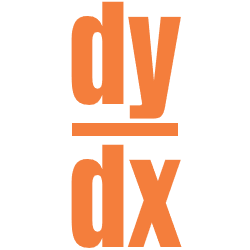Example 3: Finding the Second Derivative
|
Given: Determine . |
||
|
Step 1: Simplify and look for algebraic rewrites.
Here the equation is a simplified as we need it, and there are no algebra rewrites. You always have to check though. |
|
|
|
Step 2: Wrap the problem in a set of parentheses and the entire equation.
In this example, since we are being asked to find , you will want to the entire equation. |
|
|
|
Step 3: Look at each term as its own individual math problem, and decide what derivative rule you will need to use on each term.
In this example we have 3-terms that we must take the derivative of. |
1) : Power Rule 2) : Power Rule 3) 9 : Constant |
|
|
Step 4: Start performing the individual derivative rules.
Keep this saying in mind as you go through the process, “Every time I take a derivative, I get extra stuff.” 1) You apply the power rule to , and because you took a derivative, you get extra stuff. Since, you took the derivative of an x , your extra piece is . 2) You apply the power rule to , and because you took a derivative, you get extra stuff. Since, you took the derivative of an y , your extra piece is . 3) The derivative of a constant, no matter what method you are using, is always zero. Conclusion: Bring all the pieces back together to create your derivative equation. Not your final result, just the results of your individual derivative pieces. |
1) : Power Rule Derivative: |
|
|
2) : Power Rule Derivative: |
||
|
3) 9 : Constant Derivative: 0 |
||
|
Derivative:
|
||
|
Step 5: Clean up the equation. You work your way left to right through the equation, making sure that each term is ready for some algebra. There are three main clean up moves I look to do: 1) Cancel and combine Here we have a single that we are able to cancel. 2) Rewrites No rewrites. 3) Proper order All terms are in the proper order. |
|
|
|
Step 6: Solve for your derivative piece. In this example you are looking to find . You need to get alone on one side of the equals.
i) It doesn’t matter which side we move the pieces to. Here I will move the 2x to the right side.
ii) Now we just need to divide both sides by 2y to get alone on the left side of the equals.
iii) Cancel the 2’s out, and you have your final answer. |
|
|
|
|
||
|
|
||
|
|
||
|
Step 7 (Option 2: Find the Second Derivative, ): Take the derivative of the derivative,
This means running through Steps 2 through 6 on our derivative from the original Step 6.
i) Step 2: Wrap the problem in a set of parentheses and the entire equation. ii) Step 3: Look at each term as its own individual math problem, and decide what derivative rule you will need to use on each term. iii) Step 4: Start performing the individual derivative rules, and bring the pieces back together to form the derivative. 1) This is really just a notational housekeeping piece, that helps you better see where the second derivative notation, , comes from. 2) Here you have x ’s and y ‘s being divided, which means we must apply the Quotient Rule: . In this situation it is only when we find the dhi and the dlow , that we are taking a derivative and therefore get our extra stuff. iv) Step 5: Clean up the equation. *In the first term on top we will combine the and the -1 , and cancel out the dx’s . * In the second term on top we will combine the two negatives to get a positive, and get rid of the 1. * On the bottom we will just drop the parenthesis around the y . v) Step 6: The nice thing is the equation is already solved for , which means the only move left is to substitute our original equation into our second derivative so that the entire equation is all in terms of x and y. |
|
|
|
|
||
|
1) : Notation Move 2) : Quotient Rule
|
||
|
: Notation Move 1) |
: Quotient Rule 2)
Quotient Rule:
|
|
|
iii) The Derivative of :
|
||
|
|
||
|
|
||
|
Final Result: The second derivative of is .
Meaning: – This second derivative can be used to find the same information that any second derivative would provide.
|
||
